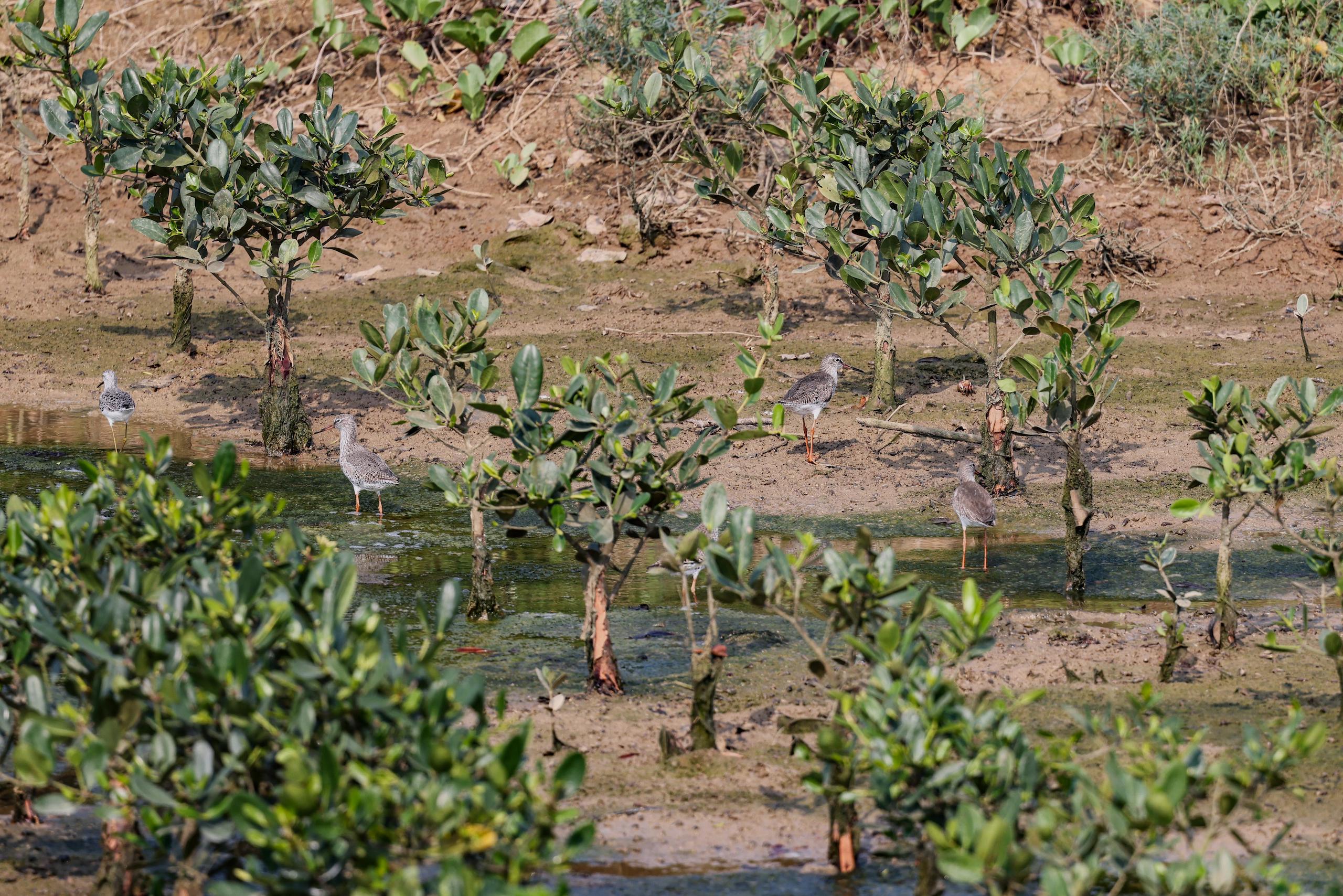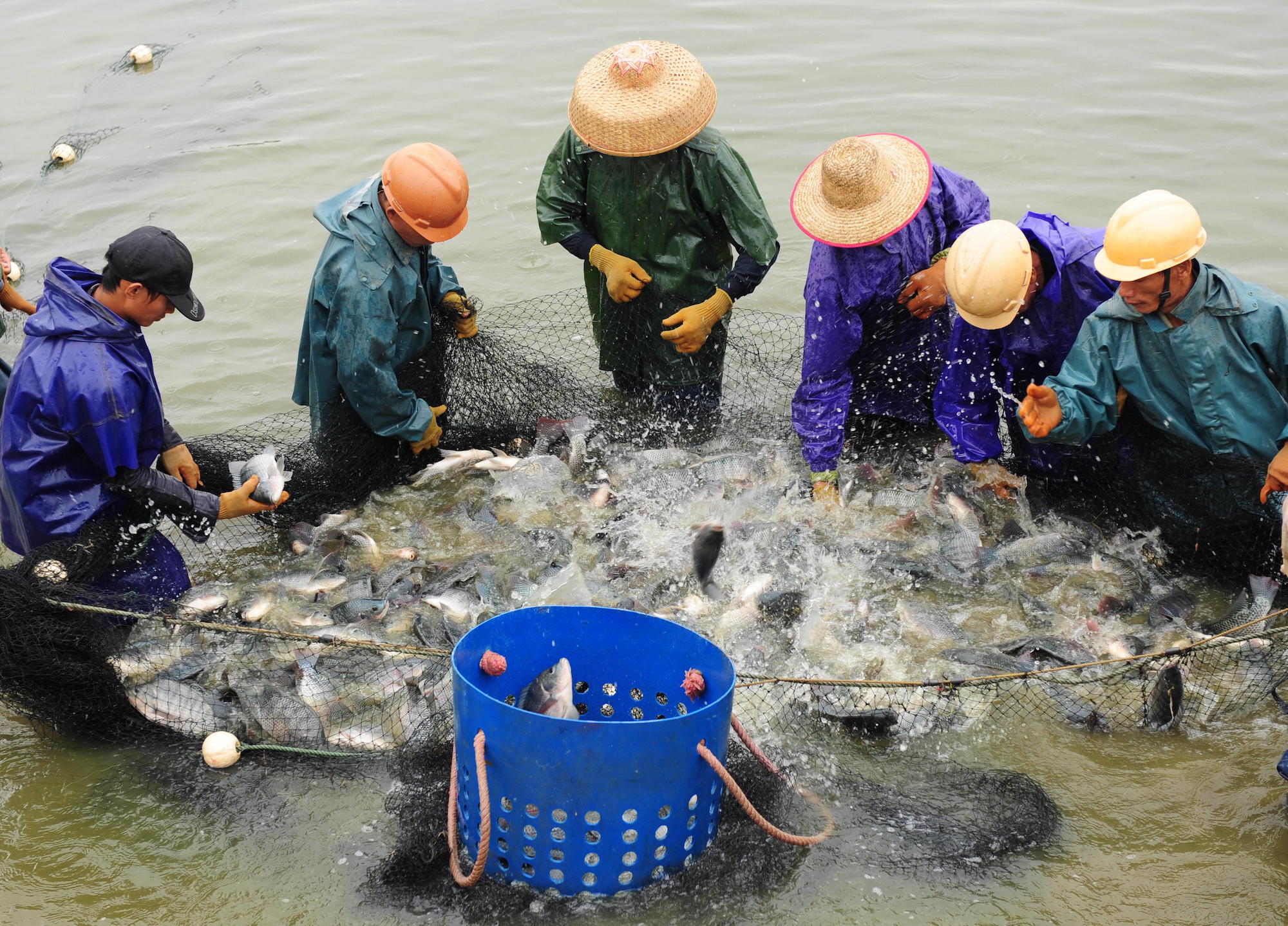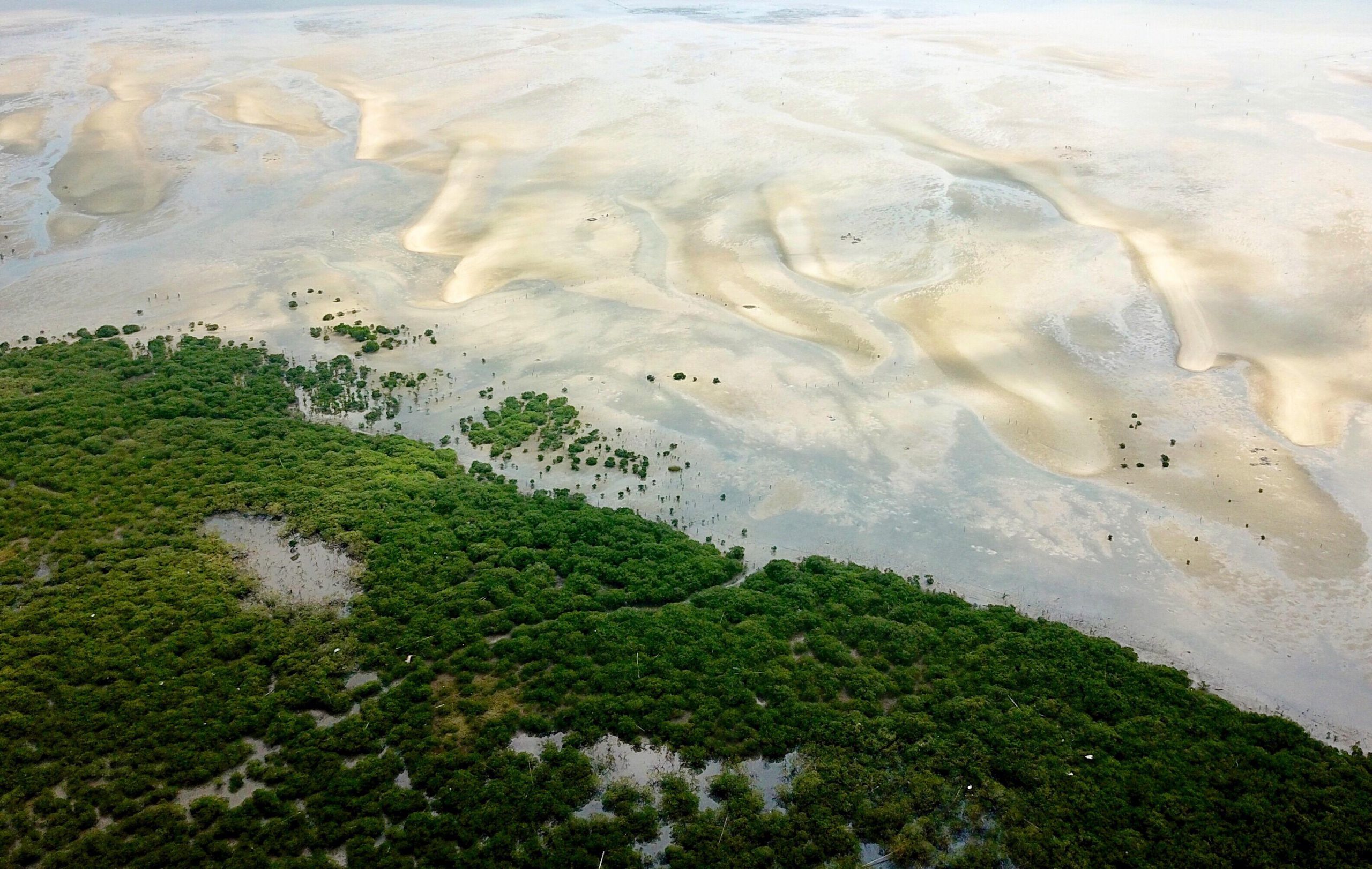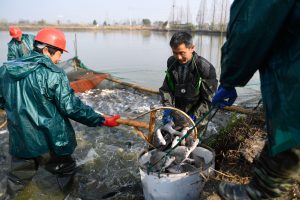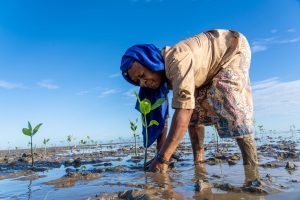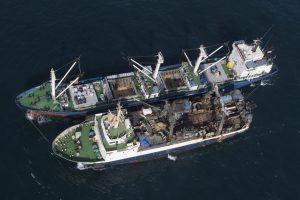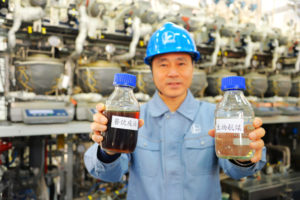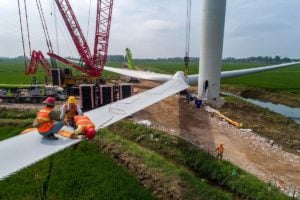The village of Dongchudao in Shandong province is bordered on three sides by the sea, with 15 kilometres of coastline and abundant seagrass.
Covering roofs with seagrass has been a tradition here since the Qing dynasty. With seagrass now also valued for ecosystem functions such as fixing carbon and providing habitat, its capacity to sequester carbon is bringing a new source of income to the local community.
But the coastal climate is fickle. Typhoons and algal blooms can cause extensive damage to seagrass beds, so their carbon-fixing efficacy cannot be guaranteed.
In May 2022, a Dongchudao aquaculture firm took out insurance with China Life for 100 mu (6.7 hectares) of seagrass it had planted. According to The Paper, the insurance covers events that damage the seagrass beds and reduce their carbon sink capacity. Each mu is insured for 2,000 yuan (US$294.75) to cover the cost of post-damage restoration.
Such insurance is available for households, cooperatives and aquaculture firms engaged in seagrass cultivation.
Dongchudao’s marine carbon sink insurance is the first of its kind in China.
In recent years, the insurance industry, as a pillar of “blue finance”, has attracted increasing attention in the field of marine conservation for providing three functions: loss compensation, risk management and capital financing. However, blue finance in China is still at an early stage. At the policy level, the government is yet to issue a “blue taxonomy”, with relevant rules and standards, and there is a lack of practical guidelines for insurers. The market, for its part, is not yet systematic, with blue finance products mainly emerging case by case at present.
Banks including Industrial Bank, Industrial and Commercial Bank of China, and Bank of China already issue blue bonds for investment and financing in various industries and regions. By contrast, insurance products for the marine sector have only begun appearing in the past two years, mostly in the form of smaller-scale products directed toward specific industries in coastal areas. For example, the carbon sink insurance for seagrass beds described above, along with a carbon sink insurance for oyster farming, also in Shandong, offer very limited coverage and cannot leverage the insurance industry’s full power for systematic marine conservation.
The insurance industry can contribute to the sustainable transition of marine-related business and support conservation of the marine environment. But developing “blue insurance” in China means first addressing the triple challenges of law, technology and policy.
Focusing on ‘environmental performance’
Marine-related industries include highly ecosystem-dependent activities such as fishing, aquaculture and coastal tourism, along with more industrialised activities such as shipping, oil and gas, renewable energy, biomedicine, and engineering and construction. These industries can result in overfishing and pollution (including noise, plastic and industrial pollution), leading to imbalances in the marine ecology, destruction of coastal and seabed habitats and eutrophication of the water, as well as directly killing marine life. Land-based industries such as agriculture, chemicals and manufacturing can also impact the marine environment as pollution sources.
To reduce such impacts, marine-related industries need to upgrade their production technologies and management approach. The insurance industry can play a role in facilitating this process.
Attaching environmental performance requirements to the provision of insurance services can spur traditional industries to transform. Marine-related industries are susceptible to weather, and they have relatively high demands in terms of methods, technology and personnel. This means they are characterised by high risk and high investment, and require robust risk management. For such industries, insurance provisions can include systematic requirements relating to environmental performance indicators like environmental compliance, production technology, and production intensity. Only producers meeting the criteria will be offered insurance services by providers.
In fish farming, for example, requirements can be placed on feed and medicine levels, production intensity and standards for waste water treatment. In 2020, an insurance product was developed for income from tilapia farming in Hainan, incorporating limits on fish density and related requirements. It was the result of a collaboration between the civil society organisation China Blue Sustainability Institute and the insurer PICC Property and Casualty Company, together with industry associations and local authorities.
For the shipping industry, requirements can be imposed concerning things like fuel use and emissions of noise and other pollutants. A related international initiative – the Poseidon Principles for Marine Insurance – requires that insurers assess and disclose whether their portfolios conform to the relevant emissions-reduction and climate targets. This steers clients in the shipping industry to adjust their business models and reduces the industry’s environmental impact. One insurance firm in mainland China – COSCO Shipping Captive Insurance Co – is currently part of the initiative.
Screening clients according to their environmental performance also helps insurers to avoid environment-related financial risks. Environmental risks include physical risks such as losses due to fish disease resulting from aquaculture, and transformation risks triggered by market and policy changes. These include changes in international and domestic environmental regulatory frameworks, changes in enforcement intensity, and increased market demand for environmental standards in production and services, which reduce the competitiveness of products that harm the environment. Environmental risks resulting from unsustainable production activities would lead to higher than anticipated payouts, constituting underwriting risks for insurance institutions.
In the process of providing insurance services, insurers can help industry entities to identify, respond to and monitor environmental risks in advance, so as to adjust their production model and improve environmental performance before their activities affect the environment. This can also reduce the level of future potential pay-outs for insurers.
Support for emerging industries
Risk management services are especially important for emerging marine-related green industries such as sustainable coastal tourism, sustainable aquaculture and offshore renewable energy. This is because these industries have low technological maturity, implying strong demand for loss compensation and risk management services. The risk points for emerging industries differ from those of traditional industries, requiring that insurers develop dedicated new insurance products to improve resilience in the industry.
Abundant capital is vital to the development of emerging marine industries. Complementary insurance products can help the relevant entities attract more capital by reducing investment risk, enhancing investment confidence in the sector and therefore optimising the investment environment.
For example, new production methods such as marine ranching – where aquatic organisms are bred and harvested in specific areas of sea – perform better environmentally than traditional methods because they generate less pollution and do not directly deplete wild fishery resources. However, marine ranches are characterised by “big investment, slow results and high risk” due to the lengthy cycle of development and production along with susceptibility to invasive species and natural disasters. Barriers to capital entry are also a factor, as is the relative difficulty of developing the industry. In 2022, Rizhao municipality saw the launch of an insurance service for marine ranching, developed especially for natural disasters such as typhoons, which pose the main risk to marine ranches. Coverage is provided by China United Property Insurance, with a 50% subsidy in the form of municipal funding, and there are now seven marine ranches insured for a total of 26 million yuan (US$3.8 million). This not only provided risk management for the companies’ operation, but has also enhanced their credit.
Offshore wind power is another emerging marine-sector industry undergoing rapid development. The transport of equipment and transmission of power are more complex than with its onshore counterparts, and offshore turbines must endure more extreme weather and seawater corrosion. Working conditions for crews handling installation, operation and maintenance are far harsher. As a result, firms can face a higher probability of risks relating to equipment damage and employee safety liability. Traditional insurance products may not be applicable for new risk configurations, so there is a need for the development of dedicated products. Dedicated insurance for offshore wind power was first introduced in China in 2008. Chinese-funded insurers such as PICC, China Pacific Insurance and Ping An are currently active in the business and have launched dedicated products for a range of risks, including all-risk insurance for construction and installation, and coverage for risks connected with power transmission, machinery damage, employer liability and personal accidents.
Mobilising more capital
In addition to helping transform the marine sector, the insurance industry can also bring in private capital to bridge the funding gap for marine environmental conservation and restoration.
Last year, at the COP15 biodiversity conference, countries agreed on the target of protecting 30% of land and sea respectively by 2030. Achieving this will require a large volume of stable, resilient funding. Annual investment of at least US$150 billion is needed globally, for which there is currently a large shortfall.
China has taken a series of marine conservation measures in recent years, including establishing marine reserves, implementing coastal restoration projects, setting ecological conservation “redlines”, and constructing “ecological seawalls”. It has also brought in action plans for specific issues such as mangrove forest conservation. The financing structure for these works is relatively uniform, with funding largely in the form of public spending. Inefficient management of fiscal resources and local fiscal pressures mean, however, that there is often a big funding gap. These problems can be alleviated by fully mobilising private capital through the mechanism of insurance.
Environmental conservation and restoration projects need to make allowance for unforeseen events, with emergency pay-outs acting as an important safeguard. At present, the relevant projects rely heavily on public spending and lack flexibility, which insurance can counter. During restoration and conservation, mangroves, coral reefs, seagrass beds, saltmarshes and other key coastal ecosystems are vulnerable to extreme weather, invasive species and pollution. With increasingly frequent hurricanes and tsunamis, against a backdrop of climate change, such ecosystems are especially susceptible to destruction of vegetation and degradation of ecological functions. Insurers can offer insurance products for ecosystems, make pay-outs commensurate with the damage caused by unanticipated events, and provide timely funding for post-disaster recovery.
Various insurance schemes of this kind are being trialled across China. These include the “Mangrove forest blue carbon environmental protection insurance” issued in 2022 to the forestry bureau of Fuding city, Fujian. It pays for recovery and restoration in the event of damage to the mangroves brought on by natural disaster or accident, including invasive species, pests and diseases. In the same year, coral reef insurance debuted in the Fujian city of Zhangzhou, covering “ecological damage or environmental pollution in the region’s maritime area due to accidents within the area”. The insurance company will “pay in advance the costs of emergency recovery and ecological restoration, so as to prevent further damage to coral reefs”. The seagrass bed insurance described earlier in this article, for its part, provides restoration funds for losses to the beds.
The value of ecological products can also be realised when insurance agencies, as beneficiaries of ecosystem services, pay for positive results generated by conservation efforts. Healthy marine ecosystems, especially coastal zone and coastal wetland ecosystems, can play a role in disaster prevention and mitigation in the face of events such as flooding and hurricanes. Green or “grey-green” infrastructure is also now being promoted in China and abroad. Green refers to infrastructures that are based on natural ecosystems like woodland and wetlands and, in the marine context, coastal zone ecosystems providing disaster prevention and mitigation. While grey-green refers to those that combine man-made structures with natural ecosystems. For example, the grey-green seawall in Dapeng New District, Shenzhen, comprises a mangrove ecosystem in the main, combined with an artificial seawall. The ecosystem services resulting from these projects can be effective in reducing insurance pay-outs for assets and safety issues in coastal areas, to the benefit of insurance companies. Those companies, in turn, can pay for such ecosystem services to fund the projects described above.
There are already international examples of this, with the Restoration Insurance Service Company (RISCO) established in 2020 by Conservation International in partnership with insurance companies. RISCO’s first project is underway in the Philippines, providing steady funding for conserving and restoring 4,000 hectares of mangrove forest. The funds come from two sources: annual fees paid by insurance companies for the mitigation benefits of mangroves, and the proceeds of carbon sink trading related to the mangroves. The plan for the first four years of the pilot is for insurers to pay $112 per hectare per year for the mangroves, rising to $160 from year five onwards. Over the first 10 years, it is expected to generate $5.2 million in fees paid by insurers and an additional $5 million from carbon-trading benefits of the mangrove forests.
Triple challenge
Although there is a role for the insurance industry in marine ecological restoration, as described above, in practice the industry is not yet systematically involved. Things are still at a trial stage, with a number of challenges waiting to be addressed.
The interconnected, shifting, hidden nature of the marine environment means that tracing and cataloguing assets in the relevant industries is quite complicated. This makes it difficult to develop, price and carry out loss verification for insurance products. Innovative insurance products for the marine sector have emerged in recent years, however, including the carbon sink insurance for seagrass beds mentioned above. This is a form of index-based insurance enabling pay-outs to be linked to indicators that can be monitored or traced, such as the speeds of sea currents and typhoon winds. Pay-outs are triggered when the relevant value exceeds a threshold, sparing the need for difficult and time-consuming onsite verification. As the above shows, in the case of such insurance products, there is an urgent need to address the technical challenges of building a good foundation of data and establishing a system for valuating environmental products.
Another challenge is the clarification of legal ownership. Marine resources fall mostly within the scope of public law, with the state enjoying the right to dispose of and manage such resources, rather than them being governed by property rights under private law. Lack of clarity around definitions of legal ownership for marine-related assets has the potential to hamper relevant transactions and hinder the development of financial products. With respect to the circulation of property rights, for example, there remain doubts about whether blue carbon can be mortgaged or pledged, aside from being bought and sold. This has affected the development of insurance products featuring pay-out criteria based on the value of ecosystem carbon sinks.
Policies are also needed to guide product development and risk management for blue insurance. Late last year, China’s Ministry of Natural Resources issued “Accounting methods for the economic value of ocean carbon sinks”, resolving the problem of quantifying such carbon sinks and determining their value. By providing a unified methodology for measuring assets, the policy makes it possible to determine the economic value of marine carbon sinks. If policy documents such as a sustainable blue industry catalogue, and blue insurance guidelines for the financial sector, could be issued and elaborated on in the future, they would provide insurers and other financial institutions with practical guidelines.
